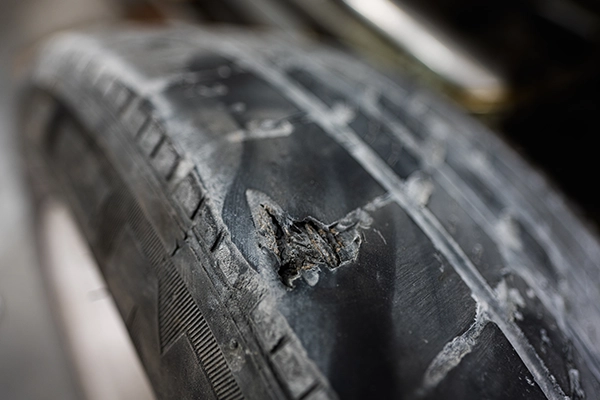Tire issues are one of the unfortunate realities of owning a vehicle. While they often last for years at a time before needing replacement, tires take a great deal of abuse from daily driving. Hard impacts, improper inflation, or simply old age can cause cracks and rips in the rubber prior to the tread reaching replacement-depth.
Oftentimes, this damage occurs on the sidewall of the tire rather than the tread itself. This leaves many drivers with the question of if they can continue driving on their damaged tires without worry. In this article, we’ll cover the common causes of a damaged tire sidewall as well as whether it’s a good idea to put off replacement.
How Does Sidewall Damage Occur?
- Impacts against objects such as curbs or medians
- Overinflation/Underinflation
- Overloading the vehicle beyond the tire’s load index
- Old age combined with extreme weather conditions
Can I Continue Driving On a Damaged Sidewall?
Generally, it’s never a good idea to drive on a tire with a damaged sidewall. Even small cracks or tears in the rubber material can cause tire blowouts and dangerous circumstances if driven on.
Sidewalls play a vital role in providing lateral stability to tires, as tires experience a great deal of lateral force when taking corners. The stress placed on the sidewalls can quickly cause failure if the sidewalls have weak points, such as cracks or weather damage.
While damage on the sidewall may be small, and easy to ignore, any damage on this critical section of your tire will gradually grow and eventually pose a major safety risk. It’s always a good idea to have your tires replaced by a trusted professional if you notice.
Types of Sidewall Damage
Tire sidewall damage may look a bit different depending on how it developed.
Bulges/Bubbling
If you notice a portion of your sidewall that is protruding outwards, this is likely due to a failure of the tire’s internal lining. While it may seem minor as the outside rubber itself is undamaged, internal lining failure likely means the structural integrity of your tire is compromised.
Cracks/Tears
The other common form of sidewall damage are tears or cracks that develop in the sidewall’s rubber as a result of impacts, old age, external conditions, or damage from road debris such as glass, nails, or otherwise.
Gouges/Scuffs
Tire sidewalls may also become damaged as a result of being gouged or scuffed, which often results due to curbing the tire or rubbing the sidewall against other sharp/abrasive surfaces. Not all scuffs on sidewalls mean your tire needs replacing, as some may not be deep enough to cause structural issues, however it’s always a good idea to have the affected tire inspected by a professional to ensure its safety.
What Counts as Sidewall Damage?
While the term sidewall refers to the actual side of the tire, damage on the tread within an inch or so of the sidewall still poses a significant risk to the integrity of your tires, as the sidewall’s structure extends further into the center of the tire.

Tire Services in Spicewood, Texas
If your vehicle has a tire with sidewall damaged, or if you’d like a professional opinion on when it’s time for a new set, don’t hesitate to schedule with the experienced technicians at Vineyard Bay Automotive in Spicewood! Our team has the training and equipment to provide your vehicle with the tire services it needs to maintain a safe and comfortable driving experience.
Don’t let tire issues linger and lead to dangerous circumstances, schedule at Vineyard Bay Automotive today for your appointment with Spicewood’s tire experts.




